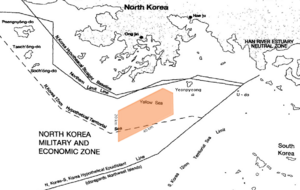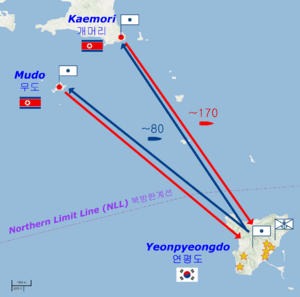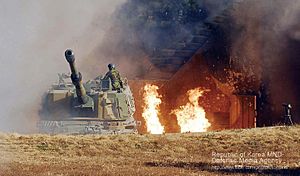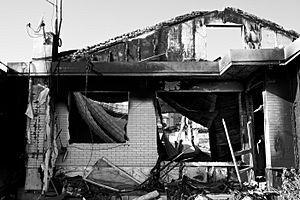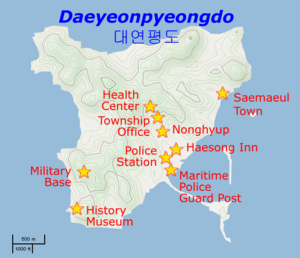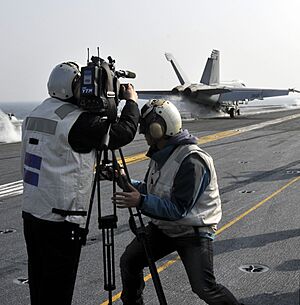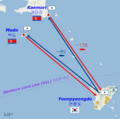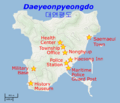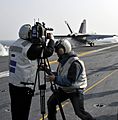Bombardment of Yeonpyeong facts for kids
Quick facts for kids Bombardment of Yeonpyeong |
|||||||
|---|---|---|---|---|---|---|---|
| Part of the inter-Korean Conflict | |||||||
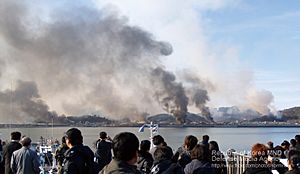 Yeonpyeong Island under North Korean artillery attack |
|||||||
|
|||||||
| Belligerents | |||||||
| Commanders and leaders | |||||||
| Kim Jong-il Ri Yong-ho Col. Kim Kyong Su |
Lee Myung-bak Kim Tae-young |
||||||
| Strength | |||||||
| One battalion BM-21 Five MiG-23 |
Six K9 Thunder SPGs Four F-15K Four KF-16 |
||||||
| Casualties and losses | |||||||
| North Korean claim: None South Korean claim: 5~10 killed and 20~30 wounded (presumed) |
2 soldiers killed 19 soldiers wounded 2 civilians killed 3 civilians wounded Two K9 self-propelled guns damaged |
||||||
The Bombardment of Yeonpyeong (연평도포격사건) was a serious event that happened on 23 November 2010. It was an artillery attack between the military forces of North Korea and South Korea. This attack took place on and around Yeonpyeong Island, which is a South Korean island.
The attack happened after South Korea held a military exercise near the island. North Korean forces then fired about 170 artillery shells and rockets. These shells hit both military areas and places where civilians lived on Yeonpyeong Island.
The shelling caused a lot of damage on the island. South Korea fired back at North Korean gun positions. In total, a few people, both soldiers and civilians, were killed on both sides. Many more were injured. North Korea later said they fired because South Korea had shot artillery into waters they claimed as their own.
This incident made the situation on the Korean Peninsula much more tense. Many countries around the world spoke out against North Korea's actions. The United Nations called it one of the most serious events since the Korean War ended.
Contents
Why the Attack Happened: The Background
A sea border between North and South Korea was set up in 1953 by the United Nations Command (UNC). It is called the Northern Limit Line (NLL). This line was drawn after the Korean War. However, North Korea does not agree with this border.
The NLL was created when countries usually claimed only three nautical miles (about 5.5 km) of water as their own. Later, in the 1970s, most countries started claiming twelve nautical miles (about 22 km). This change meant the NLL stopped North Korea from reaching some waters they felt should be theirs. It also affected their fishing rights.
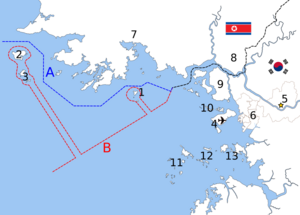
In 1999, North Korea drew its own sea border, called the "West Sea Military Demarcation Line." This line goes further south and includes rich fishing areas. But South Korea and the United Nations do not accept this new line.
Because of this disagreement, there have been several clashes between the two Koreas in these waters. There were naval battles near Yeonpyeong Island in 1999 and 2002. In 2009, another naval battle happened near Daecheong Island. In March 2010, South Korea accused a North Korean submarine of sinking their warship, the Cheonan.
Just days before the Yeonpyeong attack, North Korea showed off a new nuclear facility. This made South Korea think about asking the United States to bring back nuclear weapons to South Korea. Around the same time, South Korea and the U.S. started a large yearly military drill called the Hoguk exercise. This exercise involved many soldiers, vehicles, ships, and aircraft.
The Attack: What Happened on November 23, 2010
On the morning of 23 November 2010, North Korea sent a message to the South. They asked South Korea to stop their military exercise, saying they would not allow firing in what they saw as their waters. However, South Korean forces continued their live-fire drill near Yeonpyeong Island.
South Korean officials said their shells were fired towards the southwest, away from North Korea. South Korea's Defense Minister, Kim Tae-young, said this firing was a normal monthly drill, not part of the larger Hoguk exercise. He stated it was done about 4–5 km away from the NLL.
At 2:34 PM local time, North Korean artillery batteries began firing at Yeonpyeong Island. The attack happened in two parts: from 2:34 PM to 2:55 PM, and again from 3:10 PM to 3:41 PM. Many shells hit a military camp, but others landed in the main town. They destroyed homes and shops and started fires.
Three of South Korea's six K9 Thunder guns on Yeonpyeong fired back. Two were damaged, and one was blocked by a shell that didn't explode. South Korean artillery fired 80 shells in total. They first aimed at North Korean barracks and then at a rocket launcher.
South Korean jets were sent to the area, but they did not attack because North Korea stopped firing. South Korea's counter-attack ended at 4:42 PM. This was the first artillery battle between North and South Korea since the 1970s. It was seen as one of the most serious attacks by North Korea since the 1953 Armistice.
Power on Yeonpyeong Island went out, and many fires started. The South Korean military told civilians to go to bunkers for safety.
Timeline of the Attack
(All times are in Korea Standard Time: UTC+9.)
- 8:20 AM: North Korea sends a message asking South Korea to stop its artillery training.
- 10:00 AM: South Korea begins its artillery training.
- 2:30 PM: North Korea prepares fighter jets and a rocket launcher battalion.
- 2:34 PM: North Korea starts firing shells (about 150 shells, 60 hit military areas).
- 2:38 PM: South Korea sends out two KF-16 fighter jets.
- 2:40 PM: South Korea sends out four F-15K fighter jets.
- 2:46 PM: South Korea sends out two more KF-16 fighter jets.
- 2:47 PM: South Korea fires back with K-9 howitzers (50 shells).
- 2:50 PM: South Korea issues its highest military alert for a local attack.
- 2:55 PM: North Korea stops firing for a short time.
- 3:12 PM: North Korea starts firing again (20 shells, all hit the island).
- 3:25 PM: South Korea fires back again with K-9 howitzers (30 shells).
- 3:30 PM: South Korea sends a message to North Korea asking them to stop firing.
- 3:41 PM: North Korea stops firing.
- 4:30 PM: The first military injury is reported.
- 4:42 PM: South Korea stops firing.
- 7:00 PM: North Korea's army releases a statement saying they are serious.
- 8:35 PM: South Korean President Lee Myung-bak meets with his military leaders.
After the Attack: Impact and Responses
Casualties and Damage
The shelling caused harm to South Koreans on Yeonpyeong. Two South Korean marines were killed. Six other soldiers were badly wounded, and ten had minor injuries. Two construction workers were also killed.
Most of the island's residents were moved to safety after the attack. About 1,500 of the 1,780 people on the island were taken by boats to Incheon on the mainland. Emergency supplies, food, and medical help were sent to the island.
The attack started many fires. About 70 percent of the island's forests and fields were burned. Also, 21 houses and warehouses, and eight public buildings were destroyed.
North Korea said they had no military casualties. However, South Korea believed that many North Korean soldiers were killed or wounded from their return fire. Satellite images later showed that the damage to North Korean bases might not have been as severe as first thought.
Political and Financial Impact
South Korea called the attack a "clear armed provocation." They stopped all talks and visits with North Korea.
South Korean political parties strongly condemned the attack. The ruling party said North Korea must be held responsible for the damage. The opposition party asked North Korea to stop all actions that threaten peace.
On 25 November, South Korea's defense minister, Kim Tae-young, resigned. He was criticized for how he handled the response to the attack.
North Korea's news agency said they fired back because South Korea had made a "reckless military provocation." They warned that if South Korea entered their waters again, they would take strong military action. North Korea also said it was "regrettable" if civilians died. They blamed South Korea for putting civilians near military positions.
The attack also affected money markets around the world. Several Asian currencies became weaker, and stock markets went down. South Korea's central bank held an emergency meeting to check the impact on the markets.
Military Responses
President Lee Myung-bak told the South Korean military to attack North Korea's missile bases if there were any more attacks. South Korea said the attack was a planned and illegal violation of international agreements. They also called it an "inhumane atrocity" for firing at civilian areas.
On 24 November, the U.S. aircraft carrier USS George Washington went to the Yellow Sea for joint exercises with South Korea. This was meant to stop North Korea from further attacks and to send a message to China.
A year after the attack, South Korea greatly increased its military presence on Yeonpyeong Island. They added more howitzers, rocket launchers, and attack helicopters. They also deployed Spike NLOS missiles on Yeonpyeong and Baengnyeong Islands.
Why North Korea Attacked: Ideas and Theories
The exact reasons for North Korea's attack were not clear. North Korea said it was in response to South Korea's shelling into disputed waters. However, some experts had other ideas.
Some thought it was related to Kim Jong-un being named as the next leader of North Korea. This might have caused tension within North Korea's government. Others suggested it was a reaction to South Korea's growing importance in the world, especially after the 2010 G-20 Seoul summit. North Korea might not have liked seeing South Korea succeed. It was also suggested that the attack was a way for North Korea to get more food aid.
The JoongAng Ilbo newspaper suggested that Kim Jong-il himself ordered the attack. Kim and his son were reportedly at an artillery base near the attack site the day before.
International Reactions
Images of the shelling were shown widely around the world. The sight of burning houses caused many countries to react.
 Argentina: Condemned the incident.
Argentina: Condemned the incident. Australia: Condemned the attack and worried about North Korea's actions.
Australia: Condemned the attack and worried about North Korea's actions. Brazil: President Luiz Inácio Lula da Silva condemned any attack from North Korea to South Korea.
Brazil: President Luiz Inácio Lula da Silva condemned any attack from North Korea to South Korea. Canada: Prime Minister Stephen Harper strongly condemned the attack and supported South Korea.
Canada: Prime Minister Stephen Harper strongly condemned the attack and supported South Korea. China: Urged both sides to work for peace but did not directly condemn North Korea.
China: Urged both sides to work for peace but did not directly condemn North Korea. European Union: Condemned the attack and urged North Korea to follow the Korean Armistice Agreement.
European Union: Condemned the attack and urged North Korea to follow the Korean Armistice Agreement. Germany: Worried that the attack threatened peace and urged calm.
Germany: Worried that the attack threatened peace and urged calm. Japan: Prime Minister Naoto Kan called it an "impermissible, atrocious act" and a "grave situation."
Japan: Prime Minister Naoto Kan called it an "impermissible, atrocious act" and a "grave situation." Russia: Said that using force was wrong and that disputes should be solved peacefully.
Russia: Said that using force was wrong and that disputes should be solved peacefully. United Kingdom: Strongly condemned North Korea's "unprovoked attack."
United Kingdom: Strongly condemned North Korea's "unprovoked attack." United Nations: Secretary-General Ban Ki-moon condemned the attack, calling it "one of the gravest incidents since the end of the Korean War."
United Nations: Secretary-General Ban Ki-moon condemned the attack, calling it "one of the gravest incidents since the end of the Korean War." United States: Strongly condemned the attack and told North Korea to stop its aggressive actions. They also sent a large aircraft carrier to the area for training.
United States: Strongly condemned the attack and told North Korea to stop its aggressive actions. They also sent a large aircraft carrier to the area for training.
Images for kids
See also
 In Spanish: Bombardeo de Yeonpyeong para niños
In Spanish: Bombardeo de Yeonpyeong para niños
- List of border incidents involving North and South Korea
- North Korea–South Korea relations
- Brinkmanship


